Podcast: Play in new window | Download
Subscribe: Apple Podcasts | RSS
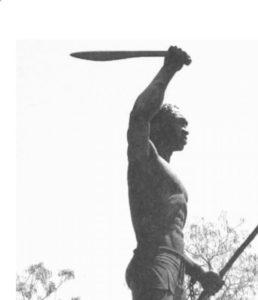 Sometime in the early 1560s, a galleon left the west coast of Africa near the modern nation of Gabon carrying a precious cargo of slaves bound for the New World. The final destination of this ship would be the colony of New Spain and the cargo onboard would be sold at the slave markets at Veracruz on the Gulf Coast. For a few decades after the Spanish Conquest of the Aztec Empire Native labor was used to work the mines and the plantations of the territories that would later become the country of Mexico. The Spanish king, Charles the Fifth, allowed African slaves to be imported into the New World as the native labor force diminished due to overwork and disease. Initially, African slaves were brought to Mexico from the Spanish colonies of the West Indies, but by the middle of the 1500s ships sailed directly from Africa to New Spain. On that galleon previously mentioned which left the area of Gabon in the early 1560s was a young man named Yanga or Nyanga. According to popular history this slave named Yanga hailed from the nobility of the West African Yang-Bara tribe and was a prince. Yanga’s inner nobility struggled to break free as he toiled on the sugar plantation called “Nuestra Señora de la Concepción”, in tropical Mexico. By 1570 he had had enough. Now known by his Christian name of Gaspar Yanga, the young and robust slave revolted against his masters. Encouraging fellow slaves to rise up, Yanga and his small group would kill 23 Spaniards who tried to subdue them. After breaking away from the plantation, he led that group of fellow Africans to freedom in the unknown inland wilderness.
Sometime in the early 1560s, a galleon left the west coast of Africa near the modern nation of Gabon carrying a precious cargo of slaves bound for the New World. The final destination of this ship would be the colony of New Spain and the cargo onboard would be sold at the slave markets at Veracruz on the Gulf Coast. For a few decades after the Spanish Conquest of the Aztec Empire Native labor was used to work the mines and the plantations of the territories that would later become the country of Mexico. The Spanish king, Charles the Fifth, allowed African slaves to be imported into the New World as the native labor force diminished due to overwork and disease. Initially, African slaves were brought to Mexico from the Spanish colonies of the West Indies, but by the middle of the 1500s ships sailed directly from Africa to New Spain. On that galleon previously mentioned which left the area of Gabon in the early 1560s was a young man named Yanga or Nyanga. According to popular history this slave named Yanga hailed from the nobility of the West African Yang-Bara tribe and was a prince. Yanga’s inner nobility struggled to break free as he toiled on the sugar plantation called “Nuestra Señora de la Concepción”, in tropical Mexico. By 1570 he had had enough. Now known by his Christian name of Gaspar Yanga, the young and robust slave revolted against his masters. Encouraging fellow slaves to rise up, Yanga and his small group would kill 23 Spaniards who tried to subdue them. After breaking away from the plantation, he led that group of fellow Africans to freedom in the unknown inland wilderness.
In the mountains of Veracruz Yanga and his group formed one of the first palenques, or autonomous communities of escaped slaves. The Spanish were aware that the palenques existed, and so were the slaves, so over time both groups – the Spanish and any slaves who managed to escape – searched for these hidden communities. Yanga’s village grew and thrived by farming and hunting, and sometimes allied with various indigenous groups, even taking in some Native people and intermarrying with them. No doubt, Yanga’s people learned much about the terrain and about how to grow and harvest local fruits and vegetables from their indigenous neighbors. For the most part, the palenques were pretty self-sufficient, although occasionally Yanga and his followers felt the need to raid Spanish caravans on the Camino Real, or Royal Road. This royal highway linked the Gulf Coast with Mexico City and the rest of the central highlands of New Spain. Much merchandise unloaded at the docks at the port of Veracruz was transported overland on this route and each caravan carried a wide variety of goods. Yanga’s people were looking for weapons and anything else that would be useful for their hidden community, such as tools, housewares and cloth. The raids on the Royal Road were relatively infrequent so as not to draw too much attention to the palenques. Over time, however, these raids became a small thorn in the side of the Spanish and got the attention of the authorities, not only in the colonial capital of Mexico City but as far away as Spain itself. It was only a matter of time before a formal confrontation would occur.
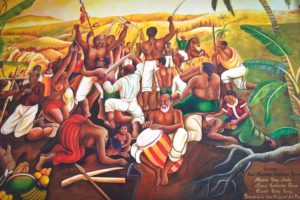 The Spanish took their first formal action in 1609, almost a full 30 years after Yanga led his small group to freedom. In January of that year an expedition led by Pedro González de Herrera left the city of Puebla. The contingent included some 550 men, of which only 100 were Spanish regulars. Conscripts, mercenaries and an assorted group of adventurers of various backgrounds made up the rest of González’ attack force. Yanga gathered together some 500 fighters from his small network of villages. Only 100 had firearms. The rest were to meet the Spanish with machetes, bows and arrows and stones. The group also used atlatls, the wooden hand-held spear throwers adopted from the local indigenous people. As Gaspar Yanga was too old to lead his people into battle, he named Francisco de la Matosa as the commander of the rebel fighters. Matosa had been captured in Angola by Portuguese slavers and had been transported to Mexico as a young boy. Yanga did not think that his people could score a victory against the Spanish, but his strategy was to cause enough damage to make the Spaniards come to the negotiating table. In the early days of the confrontation, Yanga’s people had captured a Spanish soldier and gave him terms to remit to his superiors. Yanga made his demands simple and clear:
The Spanish took their first formal action in 1609, almost a full 30 years after Yanga led his small group to freedom. In January of that year an expedition led by Pedro González de Herrera left the city of Puebla. The contingent included some 550 men, of which only 100 were Spanish regulars. Conscripts, mercenaries and an assorted group of adventurers of various backgrounds made up the rest of González’ attack force. Yanga gathered together some 500 fighters from his small network of villages. Only 100 had firearms. The rest were to meet the Spanish with machetes, bows and arrows and stones. The group also used atlatls, the wooden hand-held spear throwers adopted from the local indigenous people. As Gaspar Yanga was too old to lead his people into battle, he named Francisco de la Matosa as the commander of the rebel fighters. Matosa had been captured in Angola by Portuguese slavers and had been transported to Mexico as a young boy. Yanga did not think that his people could score a victory against the Spanish, but his strategy was to cause enough damage to make the Spaniards come to the negotiating table. In the early days of the confrontation, Yanga’s people had captured a Spanish soldier and gave him terms to remit to his superiors. Yanga made his demands simple and clear:
- He wanted self-rule of the escaped slave palenques and recognition of their inhabitants’ status as free men. In exchange, the communities would pay the Spanish Crown tribute, much as newly conquered indigenous groups had done in the past.
- Yanga promised to aid the Spanish and fight alongside them in case a foreign power attacked New Spain.
- The special self-governing district of former slaves would not take in any new escaped slaves and would return any new escapees to Spanish authorities.
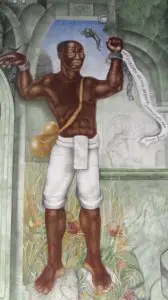 Yanga included the last provision in his demands to try to reassure any slave owners in the region who might be worried that Yanga’s special autonomous district would encourage future slave revolts and escapes. The Spanish considered carefully the terms of Yanga’s peace treaty and refused to grant them. The result was an all-out war.
Yanga included the last provision in his demands to try to reassure any slave owners in the region who might be worried that Yanga’s special autonomous district would encourage future slave revolts and escapes. The Spanish considered carefully the terms of Yanga’s peace treaty and refused to grant them. The result was an all-out war.
The Spanish found the location of Yanga’s principal village and burned it to the ground. At the Rio Blanco a large battle ensued with many casualties on both sides. The remaining population of the palenques – the women and children and some indigenous allies – and the rest of the rebel force, took to the mountains. Because they knew the terrain well, Yanga and his people waged a guerrilla war with the Spanish. The colonial government in Mexico City sent reinforcements – more regulars and more mercenaries and adventurers – to try to smoke out the rest of the rebel forces, but the best they could do is achieve a stalemate. In 1618, a full 9 years after the fighting began, under a flag of truce the Spanish sent an emissary to meet with Yanga to discuss terms. In a brief back-and-forth that lasted only a few weeks, the Spanish agreed to Yanga’s original peace treaty with two additional provisos:
- The palenques would have no contact with the outside world except for Franciscan priests who would minister to the villages. The settlements would also be open to outsiders on market days.
- Yanga’s family would be granted the right to rule over the special autonomous region in perpetuity.
Having a self-governing region of former slaves was unprecedented in the history of the Americas, but the last term in the revised peace treaty essentially established the first and possibly only African dynasty ever to have been established in the New World. The former slaves rebuilt their main village, making it the administrative and commercial center of the new autonomous region. They christened the town San Lorenzo de los Negros de Cerralvo, in honor of a Jesuit priest named Juan Laurencio who played an important role in the original negotiations in 1609. Although the inhabitants of these free communities swore allegiances to the Spanish Crown and the Catholic Church, they never paid the tribute promised in the 1618 peace treaty. The Spanish didn’t care, as long as the raids on the caravans ceased and all runaway slaves were returned, which did happen. So, the Spanish left the area alone. Yanga’s villages thrived, growing maize, beans and mangoes and remaining self-sufficient. Across time, others eventually moved into the area and blended in with the well-established free black communities. In 1932 the town of San Lorenzo de los Negros was renamed Yanga in honor of its founder and a statue was erected near the center of town soon after. The town and the statue survive to this day.
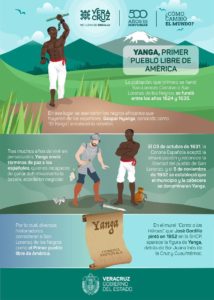 What of Yanga’s legacy? Outside the small area of the Mexican state of Veracruz very few people had ever heard of Gaspar Yanga until the publication of an anthology in 1870 called El Libro Rojo, or, “The Red Book,” in English. The author of this book was Vincente Rivas Palacio, the grandson of Mexico’s first black president, Vicente Guerrero. Rivas was the first to dub Yanga, “The First Liberator of the Americas” and brought him into Mexico’s national consciousness. Although provisions in the treaty allowed for family succession in ruling the area granted autonomy by the Spanish Crown, very little information exists about Yanga’s descendants beyond brief reports about his son in the years after the peace settlement. In fact, the modern town of Yanga, includes very few people of African decent among its population of 20,000. Researchers theorize that many original settlers of the town of Yanga intermixed with outsiders to a great degree or they relocated to nearby villages which still have visible Afro-Mexican populations. These villages are Mata Clara, Cuitahuac, Mata Caña, Cuajilote and Piedra Gorda, all in the state of Veracruz. Although the physically African population may not exist or may just exist in trace amounts in the town of Yanga today, the current citizens robustly celebrate their connection to “The First Liberator of the Americas.” Each year since the early 1980s in the middle of August the town holds their “Carnaval de la Negritud,” in conjunction with the feast to honor San Lorenzo, who has been the patron saint of the town since the days of Gaspar Yanga. The carnival has been growing in popularity over the years and has attracted the attention of tourists, especially African Americans from the United States. Researchers continue to piece together the story of Gaspar Yanga, trying to use primary source material to fill in the blanks of what mostly amounts to oral history, fragmentary historical accounts and legends. Within the past 10 to 20 years there has been great interest in Afro-Mexican identity and history, and many feel the need to put Gaspar Yanga in his proper context. For an overview of Africans in Mexico, please see Mexico Unexplained episode number 99 titled, “Afro-Mexicans, A Hidden Heritage.” https://mexicounexplained.com//afro-mexicans-hidden-heritage/
What of Yanga’s legacy? Outside the small area of the Mexican state of Veracruz very few people had ever heard of Gaspar Yanga until the publication of an anthology in 1870 called El Libro Rojo, or, “The Red Book,” in English. The author of this book was Vincente Rivas Palacio, the grandson of Mexico’s first black president, Vicente Guerrero. Rivas was the first to dub Yanga, “The First Liberator of the Americas” and brought him into Mexico’s national consciousness. Although provisions in the treaty allowed for family succession in ruling the area granted autonomy by the Spanish Crown, very little information exists about Yanga’s descendants beyond brief reports about his son in the years after the peace settlement. In fact, the modern town of Yanga, includes very few people of African decent among its population of 20,000. Researchers theorize that many original settlers of the town of Yanga intermixed with outsiders to a great degree or they relocated to nearby villages which still have visible Afro-Mexican populations. These villages are Mata Clara, Cuitahuac, Mata Caña, Cuajilote and Piedra Gorda, all in the state of Veracruz. Although the physically African population may not exist or may just exist in trace amounts in the town of Yanga today, the current citizens robustly celebrate their connection to “The First Liberator of the Americas.” Each year since the early 1980s in the middle of August the town holds their “Carnaval de la Negritud,” in conjunction with the feast to honor San Lorenzo, who has been the patron saint of the town since the days of Gaspar Yanga. The carnival has been growing in popularity over the years and has attracted the attention of tourists, especially African Americans from the United States. Researchers continue to piece together the story of Gaspar Yanga, trying to use primary source material to fill in the blanks of what mostly amounts to oral history, fragmentary historical accounts and legends. Within the past 10 to 20 years there has been great interest in Afro-Mexican identity and history, and many feel the need to put Gaspar Yanga in his proper context. For an overview of Africans in Mexico, please see Mexico Unexplained episode number 99 titled, “Afro-Mexicans, A Hidden Heritage.” https://mexicounexplained.com//afro-mexicans-hidden-heritage/
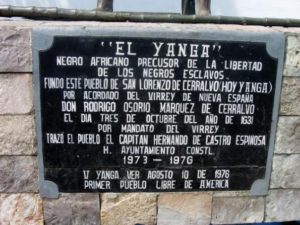 As mentioned earlier, the story of Gaspar Yanga is still being fleshed out by researchers. Some of the historical literature states that Gaspar Yanga led the first slave uprising in the Spanish colonies of the New World. Only a few keen students of history know that this is not true. The first slave rebellion in the Spanish Americas happened more than 80 years before Gaspar Yanga left his plantation. In October of 1526 a handful of slaves rose up and burned down the home of a prominent colonist in the Spanish settlement of San Miguel de Gualdape. This short-lived colony wasn’t even in Mexico. It was located somewhere in modern-day McIntosh County in the State of Georgia in the United States. Few people know of this colony which not only had the first slave rebellion in Spanish territory in the New World but was also the site of the first African slaves brought to what is now the continental United States. San Miguel was also the site of the first Catholic mass on the US mainland. This brief but interesting historical aside in no way diminishes the achievements of Gaspar Yanga and his followers. They were the first to organize a slave resistance in what would become the country of Mexico and they were the very first group in opposition to the Spanish in the New World to negotiate a treaty of peace with the Crown on their own terms, getting everything they wanted. As more researchers fill in the blanks about the life and times of Gaspar Yanga, a more complete picture of this fascinating historical liberator will emerge.
As mentioned earlier, the story of Gaspar Yanga is still being fleshed out by researchers. Some of the historical literature states that Gaspar Yanga led the first slave uprising in the Spanish colonies of the New World. Only a few keen students of history know that this is not true. The first slave rebellion in the Spanish Americas happened more than 80 years before Gaspar Yanga left his plantation. In October of 1526 a handful of slaves rose up and burned down the home of a prominent colonist in the Spanish settlement of San Miguel de Gualdape. This short-lived colony wasn’t even in Mexico. It was located somewhere in modern-day McIntosh County in the State of Georgia in the United States. Few people know of this colony which not only had the first slave rebellion in Spanish territory in the New World but was also the site of the first African slaves brought to what is now the continental United States. San Miguel was also the site of the first Catholic mass on the US mainland. This brief but interesting historical aside in no way diminishes the achievements of Gaspar Yanga and his followers. They were the first to organize a slave resistance in what would become the country of Mexico and they were the very first group in opposition to the Spanish in the New World to negotiate a treaty of peace with the Crown on their own terms, getting everything they wanted. As more researchers fill in the blanks about the life and times of Gaspar Yanga, a more complete picture of this fascinating historical liberator will emerge.
REFERENCES
